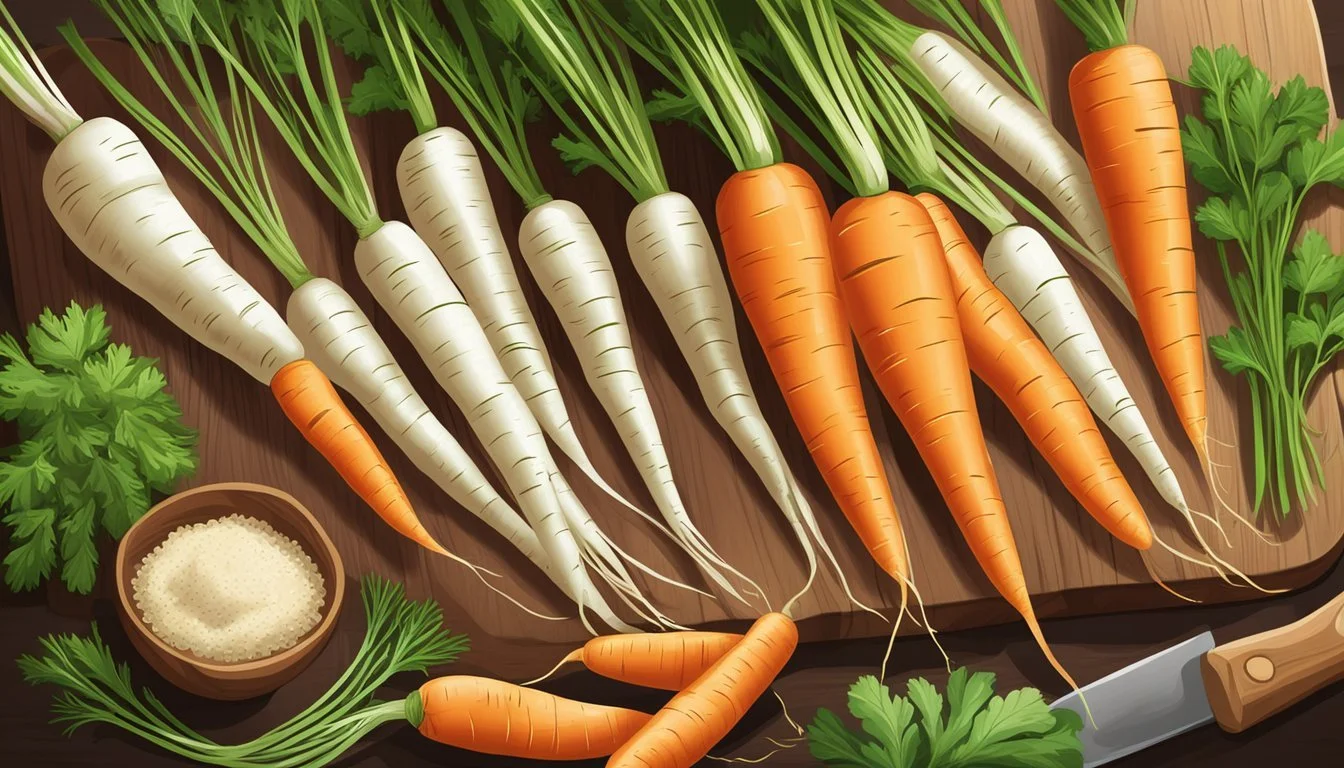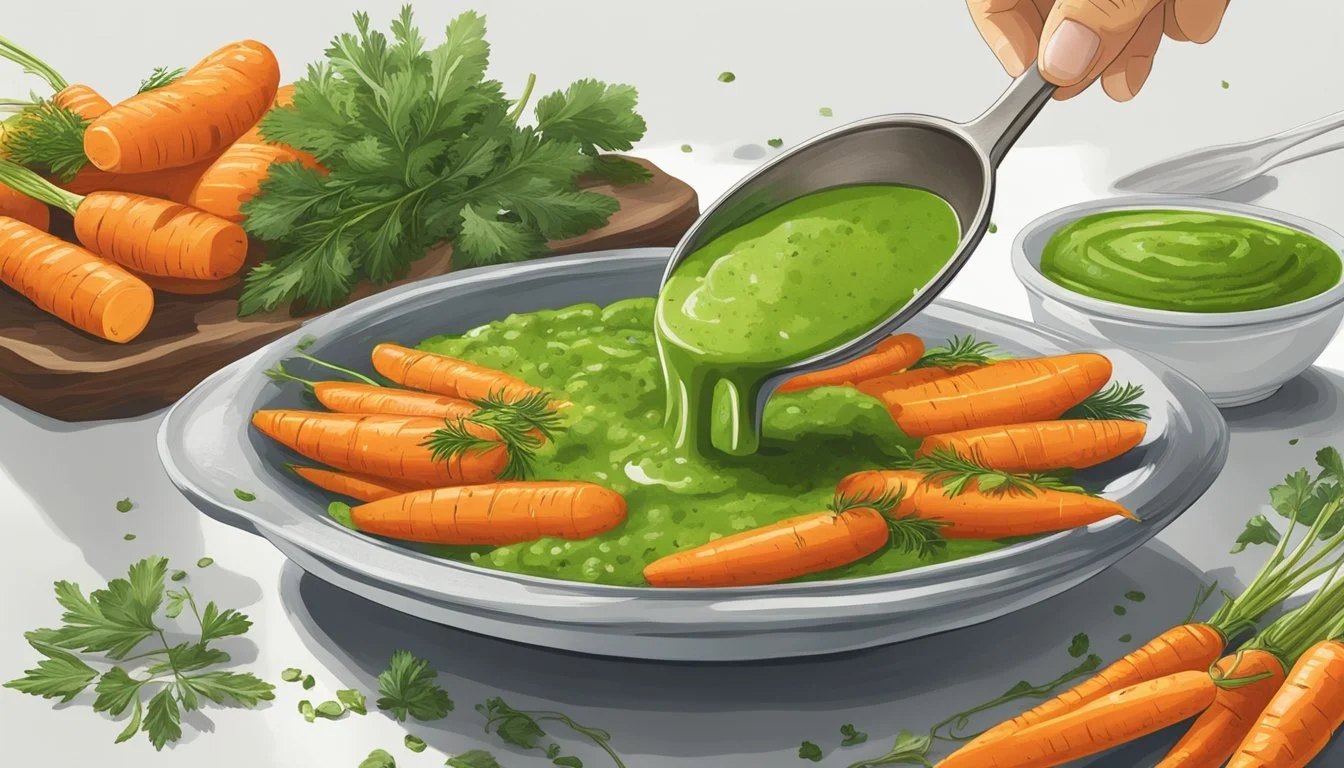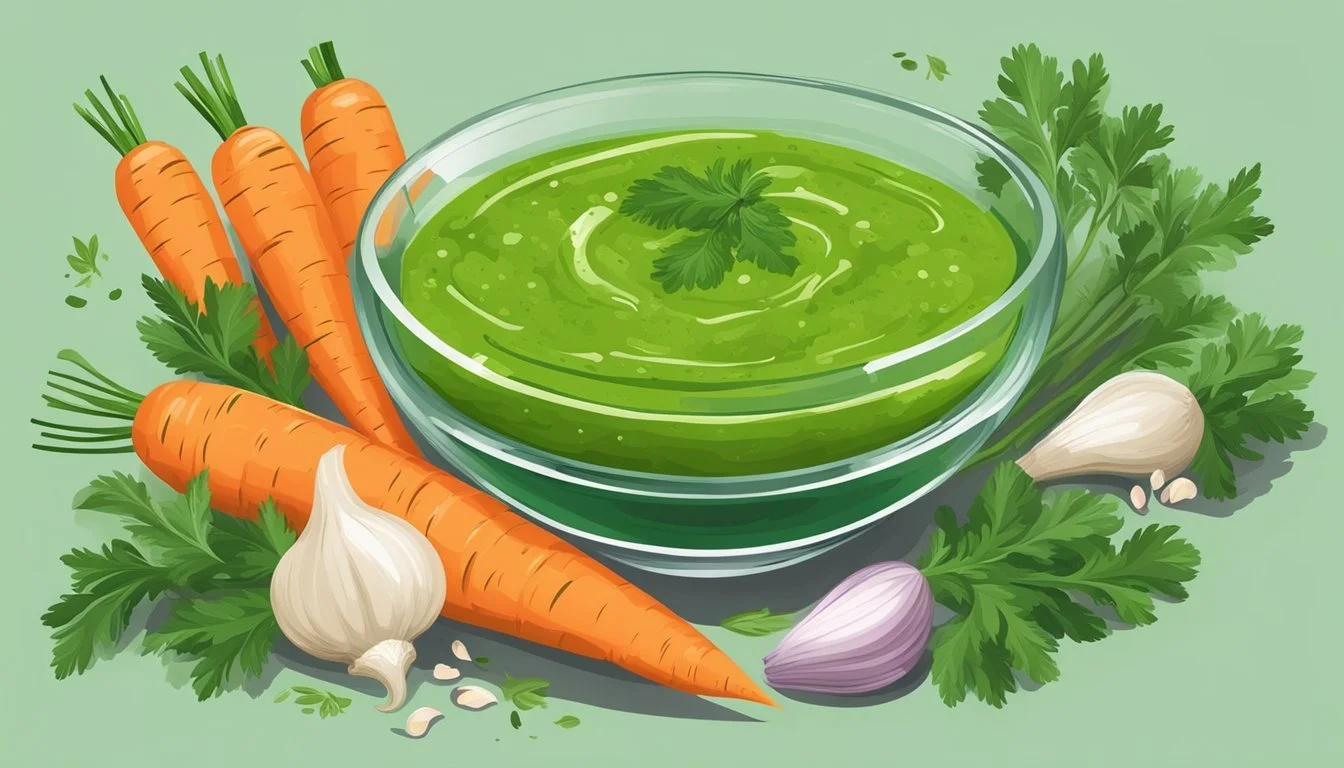Carrot Top Chimichurri
The Perfect Way to Upcycle Your Greens
Carrot Top Chimichurri is a bright and herbaceous sauce that brings a new life to the often-discarded greens of carrots. Traditionally, chimichurri hails from Argentina and is typically made with parsley, garlic, vinegar, and oil, but this variation uses carrot tops to create a unique and flavorful twist. The sauce has gained popularity for both its taste and as a smart way to reduce food waste, repurposing the leafy green tops that might otherwise be thrown away.
The use of carrot tops in chimichurri not only adds a peppery and slightly sweet nuance but also provides an excellent nutritional boost. Carrot greens are rich in vitamins and minerals and represent a resourceful approach to whole-vegetable cooking. By incorporating these leafy tops into a sauce, they complement a variety of dishes, from grilled meats (What wine goes well with grilled meats?) to roasted vegetables, (What wine goes well with roasted vegetables?) adding a zesty and fresh layer of flavor.
In creating Carrot Top Chimichurri, the process is simple but requires some attention to detail. Finely chopped carrot greens are combined with ingredients such as garlic, red pepper flakes, and oregano, which are then mixed with vinegar and olive oil. This blend sits for a brief period, allowing the flavors to meld harmoniously. The result is a versatile and delicious sauce that demonstrates how culinary creativity can lead to more sustainable kitchen practices.
Origins and Traditions
Chimichurri sauce is deeply rooted in the culinary traditions of Argentina and Uruguay, with a reputation for complementing grilled meats. Simultaneously, the use of carrot tops in cuisine reflects a growing mindfulness towards reducing food waste.
Chimichurri in Argentina and Uruguay
Chimichurri is a quintessential element in Argentinian and Uruguayan cooking. It is traditionally an uncooked sauce, historically linked to the gauchos, or skilled horsemen, of Argentina. These nomadic figures are known to have prepared this simple yet flavorful condiment to enhance the taste of their grilled meats. The primary components of classic chimichurri include finely-chopped parsley, minced garlic, vegetable oil, vinegar, and various spices like oregano and red chili flakes. Although variations exist between families and regions, its presence is ubiquitous at any barbecue, or asado, signifying both heritage and community.
Carrot Tops in Cuisine
The use of carrot tops is a relatively recent trend that helps address the issue of food waste. Carrot greens, which were once discarded, are now being recognized for their culinary potential. Chefs and home cooks have begun incorporating these verdant leaves into recipes, elevating the humble ingredient to new heights. In the context of chimichurri, carrot tops not only add a bright, herby flavor but also contribute to a more sustainable kitchen by utilizing all parts of the carrot. This approach to cooking with carrot greens reflects a broader shift towards full-plant cooking, where all edible parts of vegetables are utilized to minimize waste and maximize flavor.
Nutritional Benefits
The use of carrot tops and herbs like parsley and oregano in chimichurri offers a range of valuable nutrients. These ingredients contribute to a nutritious profile that benefits overall health.
Essential Nutrients in Carrot Tops
Carrot tops, often discarded as waste, are rich in essential nutrients. They are a green, leafy part of the carrot plant that provide various vitamins and minerals.
Vitamins: They contain vitamin C for immune function, vitamin K for blood clotting, and B vitamins for energy production.
Minerals: These greens are also a source of minerals such as potassium, calcium, and magnesium.
Health Aspects of Herbs
Herbs used in chimichurri, such as parsley and oregano, support health through their nutrient content and bioactive compounds.
Parsley: It's a herb high in vitamin C and A, which are antioxidants that protect cells from damage. Parsley is also known for its high chlorophyll content which can aid in detoxification.
Oregano: Oregano provides fiber, iron, manganese, vitamin K, and antioxidants. The phenolic compounds in oregano, like thymol and carvacrol, have been researched for their anti-inflammatory properties.
Carrot Top Chimichurri Recipe
Carrot top chimichurri is a vibrant and flavorful sauce that transforms simple ingredients into a versatile condiment. This recipe outlines how to use carrot greens to create a chimichurri with a fresh, herbaceous taste.
Ingredient List
Carrot tops: 1 cup, finely chopped
Parsley: 1/4 cup, finely chopped
Garlic: 3 cloves, minced
Olive oil: 2/3 cup
Red wine vinegar: 3 tablespoons
Oregano: 1 teaspoon, dried or fresh, chopped
Salt: 3/4 teaspoon
Red pepper flakes: 1/2 teaspoon, optional for heat
Black pepper: 1/4 teaspoon
Preparation Guide
Chopping: Start by thoroughly washing the carrot tops and parsley to remove any dirt. Shake off excess water and dry with a towel or salad spinner. Finely chop the carrot greens and parsley, either by hand or with the help of a food processor.
Mixing: In a mixing bowl, combine the minced garlic, chopped carrot tops, and parsley. Add dried oregano, red wine vinegar, salt, black pepper, and red pepper flakes if desired.
Combining: Slowly drizzle in the olive oil while stirring the mixture to ensure all components combine well.
Resting: Allow the chimichurri to sit for at least 10 minutes before serving to let flavors meld. For an even more robust flavor, one might let the chimichurri rest for up to 30 minutes.
The carrot top chimichurri can be used immediately or stored in the refrigerator. It's an excellent accompaniment to grilled vegetables, (What wine goes well with grilled vegetables?) meats, or as a vibrant addition to sandwiches and salads. The sauce typically reaches its optimal flavor within a day or two. The total time from prep to completion is around 15 minutes, making it a quick and easy way to add a burst of flavor to any dish.
Complementary Foods
Carrot top chimichurri is a versatile sauce that can elevate the flavors of numerous dishes. Here's how it pairs with a variety of foods, ranging from meats and proteins to vegan and vegetarian options.
Meats and Proteins
Steak: A robust carrot top chimichurri is a perfect topping for a grilled steak, providing a zesty contrast.
Chicken: Baked or grilled chicken breast can be transformed with this herbaceous sauce drizzled on top.
Pork: A spoonful of carrot top chimichurri on a slice of roast pork can add brightness and a burst of flavor.
Fish: Grilled or baked fish, especially salmon, pairs nicely with the tangy profile of this chimichurri.
Eggs: A dollop of chimichurri atop a poached or soft-boiled egg can add vibrancy to breakfast or brunch offerings.
Vegetables and Sides
Roasted Veggies: Carrot top chimichurri acts as a lively accompaniment to roasted vegetables, enhancing their natural taste.
Potatoes: Both roasted and sweet potatoes can be enriched with a spoonful of the zesty sauce, providing a nice balance.
Vegan and Vegetarian Options
Meat Substitutes: Vegan or vegetarian meats can be seasoned with chimichurri to infuse them with flavor without overpowering.
Vegetables: Simple steamed or grilled vegetables are elevated when carrot top chimichurri is used as a dressing or a finishing touch.
Serving and Storage
When it comes to Carrot Top Chimichurri, maintaining its freshness and vibrant flavor is essential. Understanding the proper techniques for storage, and the benefits of making the sauce ahead of time, can enhance its longevity and taste.
Proper Storage Techniques
Once prepared, the chimichurri should be stored in an airtight container to retain its flavors. It can be refrigerated for up to two weeks. If one prefers to extend this period, freezing is an option, although it may slightly alter the texture. To freeze, one should portion the chimichurri into ice cube trays or small containers, allowing for easy use in future servings.
Making Chimichurri Ahead of Time
Preparing Carrot Top Chimichurri in advance has its benefits. The flavors meld and intensify, creating a more cohesive taste. For those using a food processor, pulsing the ingredients until they are roughly chopped—not pureed—will ensure the right texture. It is advisable to reserve some fresh herbs to stir in right before serving for a burst of freshness. This pre-made chimichurri can be stored as outlined in the Proper Storage Techniques subsection, and it's recommended to let it sit at room temperature briefly before serving to enhance its flavor profile.
Variations and Substitutions
Carrot top chimichurri can be customized to suit individual tastes through various herb and vinegar substitutions as well as spice adjustments. These modifications not only tailor the sauce to personal preferences but can also complement the dish it accompanies.
Alternative Herbs and Vinegars
Using alternative herbs can dramatically change the profile of the sauce. While carrot tops offer a distinct flavor, one can incorporate other herbs such as basil or cilantro, either in part or as replacements, to achieve a different nuance of taste. Instead of red wine vinegar, one might opt for lemon juice or lime juice to create a more citrus-forward chimichurri. For those who prefer a stronger tang, apple cider vinegar is a robust alternative.
Herbs: Try blending in basil or cilantro with the carrot tops.
Vinegars: Swap red wine vinegar for lemon juice, lime juice, or apple cider vinegar.
Spice Adjustments and Additions
Spice levels in carrot top chimichurri can be tailored using red chili, red pepper flakes, or even a pinch of chili powder for heat. To add complexity, one can experiment with the form of oregano used; fresh oregano gives a brighter flavor compared to the more concentrated taste of dried oregano.
Heat: Add or reduce red chili, red pepper flakes, or chili powder according to tolerance.
Oregano: Use fresh oregano for a vibrant flavor or dried oregano for a deeper profile.
Tips for Best Results
Achieving the perfect Carrot Top Chimichurri involves careful attention to the texture of the sauce and the balance of its bold flavors. It is important to understand that the details in preparation can make a significant difference in enhancing the sauce's vibrant character.
Achieving the Perfect Consistency
For the carrot top chimichurri, texture is paramount. A food processor can be used for convenience, but to ensure the sauce retains a rustic texture which is key for this dish, chopping by hand is recommended.
Hand chopping: This method gives control over the fineness of the greens and allows the sauce to have a more desirable texture. Do not over-chop; the goal is to have discernible bits rather than a paste.
Food processor: If using a food processor, be cautious with pulsing. A few quick pulses are sufficient to chop the carrot tops but maintain some structure.
Balancing Flavors
The flavor profile of carrot top chimichurri should be bright and herbaceous with a balance between acid, the fresh flavor of herbs, and an earthy undertone from the carrot greens.
Acid: Start with a small amount of vinegar and adjust as needed. The acid should complement the other flavors, not overwhelm them.
Salt: Use salt to enhance the natural flavors of the ingredients. Sea salt or kosher salt is preferred for its clean taste.
Earthy Notes: The carrot tops themselves contribute an earthy flavor that is unique to this sauce. These should be fresh and vibrant in color for the best taste.
Tasting: Frequently taste the chimichurri and adjust the seasoning, keeping in mind that flavors will continue to develop as the sauce sits.
Usage in Different Cuisines
Carrot top chimichurri is a versatile condiment that enhances a variety of dishes across multiple cuisines with its vibrant herbs and earthy flavor. This adaptation of the classic South American sauce employs underutilized carrot greens, promoting a no-waste philosophy in the kitchen.
Traditional South American Pairings
In South American cuisine, chimichurri serves primarily as a condiment for grilled meats. The sauce's bold flavors complement the smoky profile of barbecued beef, particularly in Argentina and Uruguay. It's not uncommon to find chimichurri drizzled over choripanes (chorizo sandwiches) or as a vibrant topping on staple side dishes such as empanadas. The usage of carrot tops adds an extra dimension of earthiness to the chimichurri, distinguishing it from other versions of the sauce.
Grilled Meats: Enhances the taste with a herby zest.
Choripanes: Offers a fresh twist to the traditional sausage sandwich.
Empanadas: Adds a layer of complex flavors to the beloved pastry.
Incorporation into Global Dishes
The inventive carrot top chimichurri has transcended its South American roots to become a welcome addition in global dishes. Its versatility allows it to be a flavorful addition to sandwich spreads, enhancing the taste with a herbaceous punch. Salads and soups also benefit from a spoonful of chimichurri, providing a fresh, tangy contrast to the greens or the richness of broths. This sauce aligns well with the global trend towards sustainability in food choices and can be considered a culinary bridge between various food cultures.
Sandwiches: A fragrant spread that offers a bright flavor note.
Salads: Introduces an unexpected zest that pairs well with mixed greens.
Soups: Serves as a garnish that adds depth to each spoonful.
Creative Leftover Ideas
Making the most of leftovers is not only economical but also an excellent approach to reducing food waste. This section explores inventive ways to utilize leftover Carrot Top Chimichurri, enhancing dishes while keeping food sustainability in mind.
Reducing Food Waste
Carrot greens, often discarded, find new life in Carrot Top Chimichurri, directly addressing the issue of food waste. A seldom-used ingredient, carrot tops, can complement various recipes, mimicking the role of herbs like parsley. For example:
Pesto Replacement: Use leftover chimichurri as a substitute for pesto in pasta dishes or spread on sandwiches.
Walnut Pesto: Mix it into a walnut pesto for a nutty, herby flavor expansion.
People can further minimize waste by incorporating remaining chimichurri into:
Dish Type Suggested Use Soups and Stews A dollop in a bean stew provides a zesty kick. Vegetable Sides Toss over roasted carrots or asparagus for an instant upgrade. Leafy Greens Dress spinach or other salad leaves for a refreshing side dish. Main Courses Brush some on grilled meat or tofu for a herbaceous twist during the last cookout.
The versatility of Carrot Top Chimichurri aligns with an environmentally conscious kitchen, transforming peelings and leftover greens into a star component.
Innovative Pairings
Carrot Top Chimichurri is not just a sauce; it's an inspiration for innovative pairings. Its bright, tangy flavor profile complements a range of dishes:
Bread: Brush leftover chimichurri over crusty bread and toast lightly for an aromatic appetizer or side.
Beans: Stir into warm beans for an unexpectedly delightful taste.
Roasted Vegetables: Elevate the flavor of roasted carrots or asparagus with a spoonful of chimichurri.
Protein: Enhance the natural flavors of grilled chicken or fish by using it as a vibrant finish.
Chefs and home cooks can confidently use Carrot Top Chimichurri to create signature dishes that are as responsible as they are delicious. The sauce’s ability to meld with other ingredients showcases its utility in the kitchen, beautifully repurposing leftovers.
Frequently Asked Questions
This section addresses common inquiries regarding the nutritional content, potential allergens, and the environmental impact of Carrot Top Chimichurri, providing readers with concise information to make informed choices.
Nutritional Information
Carrot Top Chimichurri is a low-calorie condiment that typically contains a variety of nutritious vegetables and herbs. It can be a source of vitamins and minerals, predominantly from leafy greens like kale and carrot tops. The sauce's caloric value is relatively minimal, but one should consider the olive oil content, which can increase the total calorie count. However, olive oil is also a source of healthy fats.
Calories: Ranges due to portion size and oil quantity
Veggies: Carrot tops, kale (can be included for extra nutrients), onion
Herbs: Parsley, cilantro leaves, basil (options for varied flavor profiles)
Allergen Information
Carrot Top Chimichurri is naturally gluten-free, making it a suitable choice for individuals with gluten intolerances or celiac disease. It is essential to check all individual ingredients, as packaged spices and vinegars may sometimes contain gluten or be processed in facilities with gluten-containing products.
Gluten-Free: Yes, when using gluten-free vinegar and spices
Sustainability Concerns
Utilizing carrot tops to make Chimichurri aligns with sustainability practices, such as reducing food waste. Those participating in a community-supported agriculture (CSA) program may find this recipe particularly beneficial for using up the entirety of their vegetable share. It's a simple, versatile way to incorporate often-discarded vegetable parts, such as carrot greens, into a usable, delicious condiment.ILTER
CSA: Ideal for utilizing full vegetable share
Food Waste: Reduces by incorporating carrot tops
Recipe Simplicity: Encourages frequent use and reduces waste







